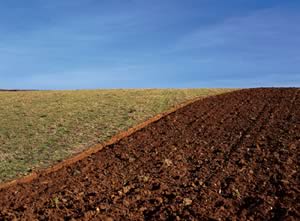 |
|||||||||
|
|||||||||||||||||||
|
|
Ponder Before You Plough 2009-09-24 Once again, harvest has been delayed by wet weather - especially two weekends ago when very high rainfall fell over the weekend. However, recent dry spells have allowed some catch up time and progress has been made. Nevertheless the effects of all that rain on our soils are easy to see with ruts, tracks and compaction. SAC soil specialists say farmers anxious to get new crops in the ground ignore that at their peril.
Harvest is the time of year when the soil is most compacted. Combines, laden grain trailers, balers and bale handlers give the soil a beating. The wetter the soil, the greater the compaction - and the heavier the machinery, the deeper the compaction goes and the more difficult it is to remove. The wet conditions have delayed the establishment of winter crops. It is important now not to further damage the soil by working the soil when it is wet. Recent research at SAC and SCRI showed that about one third of our soils have a structure which restricts root growth and 10 percent of soils have a low macroporosity leading to anaerobic (no air) conditions. This survey was carried out before the 2008 wet harvest. Subsoil compaction is also a likely problem in Scottish soils as vehicle weights get greater and soils get wetter. A recent study in the Netherlands showed that 50% of the most fertile and productive soils in the Netherlands have over-compacted subsoils. This is a subject of current research investigation at SAC/SCRI/MI where we hope soon to map the risk of subsoil compaction in Scottish soils Ploughing wet soil can destroy the soil structure which is fundamental to providing good conditions for crop growth and controlling greenhouse gas emissions from the soil. The more compact and smeared the soil, the greater the likelihood of waterlogged crops and of the release of the potent greenhouse gas nitrous oxide. Please try to wait to cultivate when the soil has dried to avoid soil damage. According to SAC soil specialist Dr Bob Rees this may even involve waiting until the spring. “With margins for some cereals quite small, it may be worthwhile allowing the soil to recover its production potential rather than puddling in a crop which will give low yields. This year, I noticed poor soil conditions and growth in some normally highly productive soils as a result of last year’s wet harvest.” Dr Rees and his colleagues have some important tips. It is really important to maintain a good soil structure, particularly the macropores which are particularly important;
Harvest compaction blocks macropores and reduces water infiltration leading to wet soil conditions, losses of nutrients and possible erosion. It is important to restore this soil drainage function. Areas of damaged soil are shown as pans, clods, smeared surfaces or smelly layers. They can be detected in a simple guide on soil structure produced by SAC and colleagues from Aberdeen and Aarhus universities (Visual Soil Structure Quality Assessment). Compaction remediation may need to wait until next year and includes:
But however good these techniques may be it is still best to avoid compaction in the first place.
Another solution for reducing crop and environmental losses associated with compaction is to use controlled traffic systems. These use GPS technology to localise as many wheel tracks of tractors as possible to the same areas of the field leaving the rest of the field traffic free. Both wheel track area and traffic-free areas are under cropping. The overall effect, in research based in Bedfordshire, Australia and China is to increase crop yields and reduce cultivation energy with fewer gaseous and leaching losses to the environment.
|
||||||||||||||||||

|
|
||||||||||||||||||
| home | agri-services | pedigree
pen | news | dairy | beef | machinery property | organisations | site map |
|||||||||||||||||||

